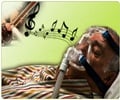
‘Brain scans reveal that patient and therapist's brains synchronize during music therapy. ’
Tweet it Now
"Music therapists report experiencing emotional changes and connections during therapy, and we've been able to confirm this using data from the brain," said study lead author Jorg Fachner, Professor at Anglia Ruskin University in the UK. "Music therapists have had to rely on the patient's response to judge whether this is working, but by using hyperscanning we can see exactly what is happening in the patient's brain," Fachner said.
During the session documented in the study, classical music was played as the patient discussed a serious illness in her family. Both patient and therapist wore EEG (electroencephalogram) caps containing sensors, which capture electrical signals in the brain, and the session was recorded in sync with the EEG using video cameras.
According to the researchers, music therapists work towards "moments of change," where they make a meaningful connection with their patients.
At one point during this study, the patient's brain activity shifted suddenly from displaying deep negative feelings to a positive peak. Moments later, as the therapist realized the session was working, her scan displayed similar results.
Advertisement
By analyzing hyperscanning data alongside video footage and a transcript of the session, the researchers were able to demonstrate that brain synchronization occurs, and also show what a patient-therapist "moment of change" looks like inside the brain.
Advertisement
Source-IANS











